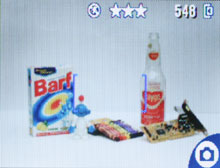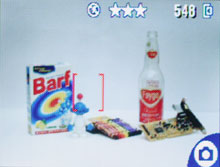Recording Features
In all recording modes, the CX7330 records images as JPEG files. The resolution options are below:| Setting | Resolution (pixels) |
| Best *** | 2032x1524 |
| Best (3:2) *** | 2032x1354 (3:2) |
| Better ** | 1656x1242 |
| Good * | 1200x900 |
All resolution options are in a 4:3 aspect ratio, except for the second setting. The aspect ratio of 4:3 is the same as a standard TV screen, whereas 3:2 is the same as a 4"x6" print. The CX7330 offers 6 available recording modes: Auto, Sport, Night, Landscape, Close-up, and Video. Ironically, although Auto mode is a general purpose shooting mode, it actually offers the largest amount of control because most of the other modes are presets for specific situations. Like all the shooting modes, in Auto mode, the camera will determine automatically the appropriate aperture and shutter speed to produce a good exposure. Sport mode enables the fastest possible shutter speed to capture fast-moving subjects. In Night mode, the CX7330 can take images with shutter speeds as slow as 0.5 seconds. When the flash is enabled, the camera will perform a slow-sync flash. This means that it will first fire a flash to illuminate the subject. Then, the shutter will stay open longer to allow ambient light to fill in the background details. This slow-sync method provides natural-looking flash pictures. A tripod is highly recommended due to the longer exposure time. Landscape mode uses a small aperture opening in order to keep both the foreground and background in focus. In Close-up mode, the camera can focus on objects as close as 5.1 inches at wide angle and 8.7 inches at telephoto.
In all still recording modes, there are several flash options available: Auto, Flash Off, Fill Flash, and Red-eye. With Auto flash selected, the camera will determine automatically whether or not to fire the flash when the picture is taken. Fill Flash is known as "Force Flash" on some cameras and can be used to fill in shadows on subjects that may be caused by harsh lighting. The Red-eye option fires a pre-flash to contract the subject's pupils before taking the picture with the real flash.
 Normal display |
 Focus locked |
The CX7330 displays brackets to indicate the status of a focus attempt. The camera can focus on one or more points at a time. If focusing is successful, the brackets will appear red. If focusing fails, the brackets will disappear and the Ready lamp will blink red. By pressing the Self-timer/Burst button, you can set the camera to take multiple pictures in a row or to take a self-timer shot. After selecting the burst option, simply half-press the shutter button to lock the focus and exposure. By pressing down the shutter button and holding it, the camera can take up to 3 pictures in succession at full resolution. Since this camera is a true "point and shoot", there are no options to adjust the white balance or metering. The camera uses automatic white balance and multi-pattern metering at all times. Multi-pattern metering works by measuring the light from areas all over the frame. Then, the camera makes a calculation to determine what the best settings should be to produce a proper exposure.
By pressing the Menu button, there are a number of shooting options that can be adjusted. Below, we have outlined these options in a table:
| Menu | |
| Image Storage | Auto, Internal Memory |
| Exposure Compensation | +/- 2 stops in 1/2 stop increments |
| Picture Quality | Best ***, Best *** (3:2), Better **, Good * |
| Color Mode | Color, Black & White, Sepia |
| Set Album (Still) | Exit, Birthday, Holiday, Wedding |
| Date Stamp | Off, YYYY/MM/DD, MM/DD/YYYY, DD/MM/YYYY |
| Orientation Sensor | On, Off. |
| Setup Menu | Enter |
The Image Storage setting allows you to select where you would like images to be saved. If "Auto" is selected, the camera will save images to a media card if one is detected. Otherwise, it will save images to the internal memory instead. With the "Set Album" option, you can tag images so that they can be easily found with the bundled software. For example, if you choose one of the options, all the images you shoot will be grouped together when you view them later. The "Orientation Sensor" option can be enabled so that the camera will rotate portrait style images automatically for you. This saves some time later when you are viewing/editing. The Setup menu offers some additional options pertaining to operational settings.
| Setup Menu | |
| Return | Enter |
| Default Print Quantity | 1 - 100 |
| Quickview | On, Off |
| Liveview | On, Off |
| Advanced Digital Zoom | Continuous, Pause, None |
| Date & Time | Set |
| Video Out | NTSC, PAL |
| Language | Select |
| Format | Memory Card, Internal Memory, Cancel |
| About | OK |
The "Default Print Quantity" option simply sets the default number of pictures for printing. If "Quickview" is enabled, the camera will briefly display an image immediately after it is taken. "Liveview" refers to the LCD preview capability. If this is set to "Off", the LCD monitor will be disabled by default. However, it can be enabled again by simply pressing the center of the directional controller. The settings under the option "Advanced Digital Zoom" refer to the behavior of the digital zoom. If "Continuous" is selected, the digital zoom will begin automatically as soon as the optical zoom reaches its limit. If "Pause" is selected, the digital zoom will not begin until the zoom controller is released and pressed again.
As you might expect from an entry-level, point-and-shoot camera, the movie functionality of the CX7330 is fairly average. It offers 15 fps video at 320x240 with sound. The files are recorded as Quicktime (MOV) files and are only limited by the remaining available recording space. While recording, both the optical and digital zoom are disabled. Just like in a still recording mode, the option "Set Album (Video)" is available via the Menu button. This allows you to tag video clips for easier organization later.










16 Comments
View All Comments
Jeff7181 - Friday, December 31, 2004 - link
Nice article... would have been nice to see it BEFORE the holidays though ;)stephencaston - Friday, December 31, 2004 - link
#4,Unfortunately, when it comes to digital cameras, it is impossible to cover every camera at a specific price point. We had to make choices when picking which cameras to use and ended up choosing three cameras at $150 with very similar features to make the comparisons more relevant.
I did not mean to imply that this article will determine the best camera at $150. The article was meant to compare these three cameras to each other. I have amended the title accordingly to reflect this.
We always encourage people to do as much research as possible before buying a camera. There are so many different things to consider when reviewing digital cameras and each review site focuses on different areas.
PrinceGaz - Friday, December 31, 2004 - link
I'd take the Minolta DiMAGE X31 over any of the cameras reviewed any day; it's a lot more compact than them which is what many people desire when out and about, is reported to give a good picture for it's price and size, has lots of features, and at $150 is just as cheap as them. My DiMAGE X20 is a lovely little camera that does everything you could ask of it, and from what I've read the X31 makes a good thing better.I will reiterate a point I made when digicam reviews first appeared on AT, which is that unless you can review *every* model in depth to find which is the best in that category, then you are doing a dis-service to your readers by potentially not even looking at what might be the best camera in that range.
Specialist digicam websites review all cameras so that they can give an informed opinion on any new models, even if that means buying one themselves like AT might do for a computer product that free review samples weren't available for. What AT is doing with digicam reviews is just picking two or three models out of the many available and saying one of them is the best, when better ones you didn't even look at are available. AT does excellent reviews of computer components, but I'm afraid you'd have to be a fool to only use your recommendations when buying a digicam.
orenb - Friday, December 31, 2004 - link
The best digital camera at this price point is the Ricoh Caplio RX. 28-100mm zoom. Metal body. Almost no shutter lag. These three don't even come close.Prog.
Joony - Friday, December 31, 2004 - link
The Canon A400 should be in this review...cosmotic - Thursday, December 30, 2004 - link
Again, Kodak EasyShare is turned into an ad link and blends into the background of the table cell.